Piercing Fortress Europa: A sneaky, good game
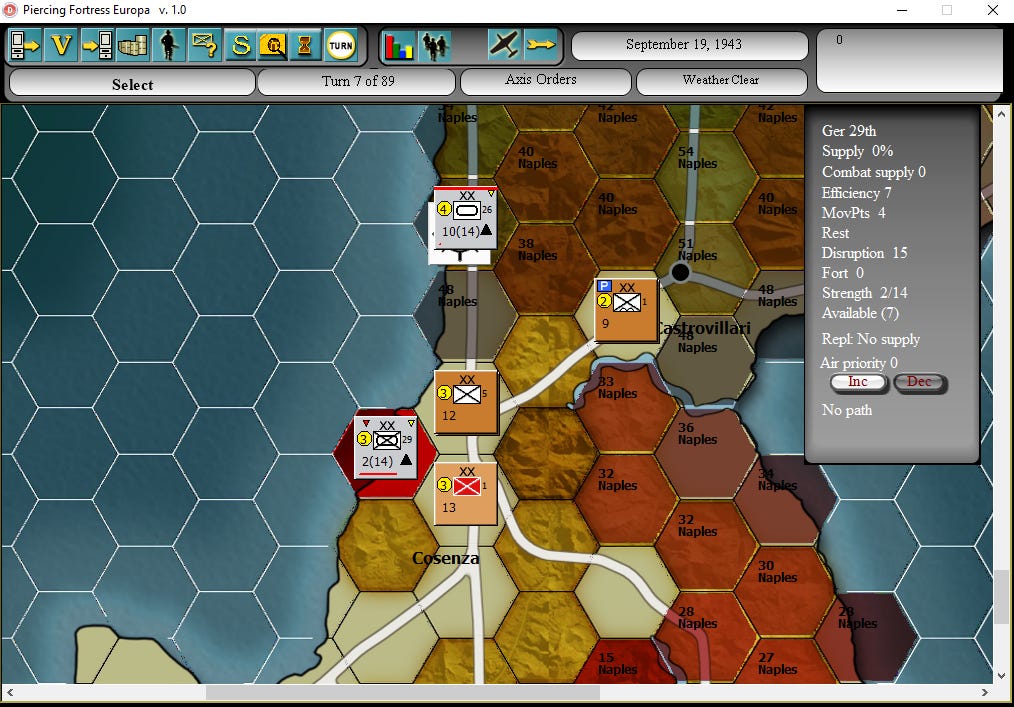
I call this “The agony of the 29th Panzergrenadier division.”
I have often said to myself that if I ever come into money, I am going to try to buy the rights to the Command Ops game engine from its current owner. This is the only wargame I have ever said this about until now, please add Piercing Fortress Europa to that exclusive list.
This is a sneaky good game which is currently on sale for $9.60 (regular price is $39.99. You can purchase it here. I actually purchased it for around $6 after I leveraged my 6 year Matrix anniversary coupon and their Christmas sale. I also purchased AGEOD’s “To End All Wars” WWI strategy game and it’s DLC for $9+ (Christmas sale + discount coupon!).
Back to PFE, in 2014 when the game came out, Patrick Baker the Armchair General reviewer had this to say (emphasis mine):
Bottom LineUltimately, although Piercing Fortress Europa is a niche game, it is a very good one. Gamers interested in exploring the effects of logistics on modern warfare will enjoy this game, or those equally interested in the Sicilian and Italian operations will find the challenge enjoyable, engaging and educational. However, the game’s nearly $40 dollar US price, its unflashy graphics, and its somewhat restricted historical focus may keep others away. But they’ll be missing out on a well-designed operational simulation of the Second World War.
I completely agree and have stayed away from the game because of the steep price, but now that it is heavily discounted, wow am I glad I purchased it.
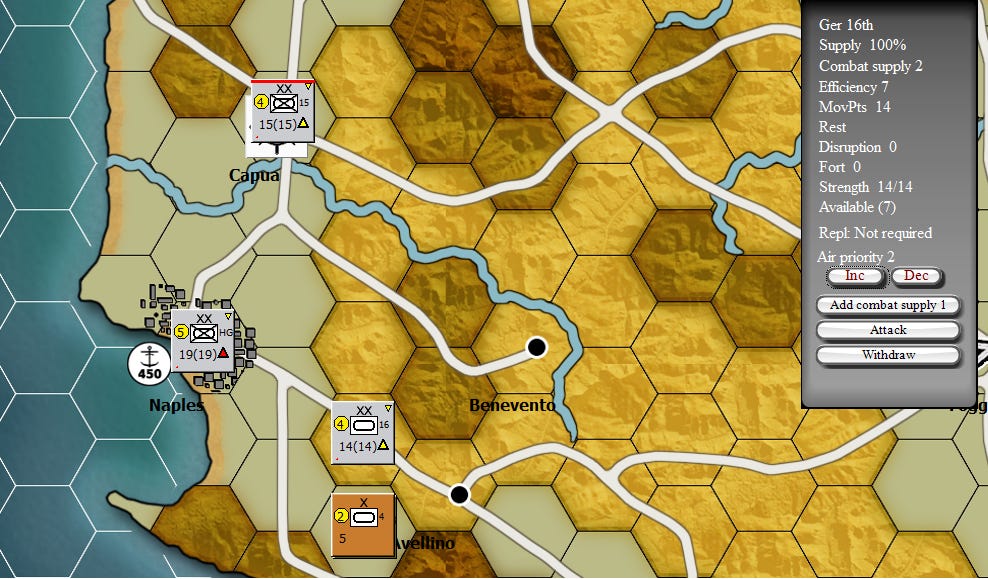
“The initial defense of Naples.”
This game has a number of flaws that may be disqualifying for you, and I’ve rated some of them to show you how bad I think they are.
- Clunky command interface (Grade D)
- Poor map graphics (Grade C)
- No sound (this is a personal preference, not necessarily a flaw)
- Eliminated units are left as ghost counters on the overview map (a very minor problem, but this can be confusing)
- Clunky window system (they should upgrade the interface to windows that can be dragged open and are moveable (overview map I am talking about you)).
- No river and mountain labels (and the German defense centers on river and mountain lines)
For me, this game scratches the operational itch though:
- With command decisions centering around the maintenance of crucial supply points.
- The forced prioritization of combat decisions, because of the supply emphasis.
- By making the addition of replacements a decision point.
- By making the prioritization of air cover a decision point.
It also has:
- A turn-based WEGO system (which I love)
- Challenging AI
- The game consequently is free-flowing and fast-playing.
The Fight for Naples an AAR:
I am currently playing one of the larger scenarios which goes deep into 1944. It is October 1943 though and the Allies and German army are slugging it out on the verdant plain outside of Naples and in the hills to the east of the city.
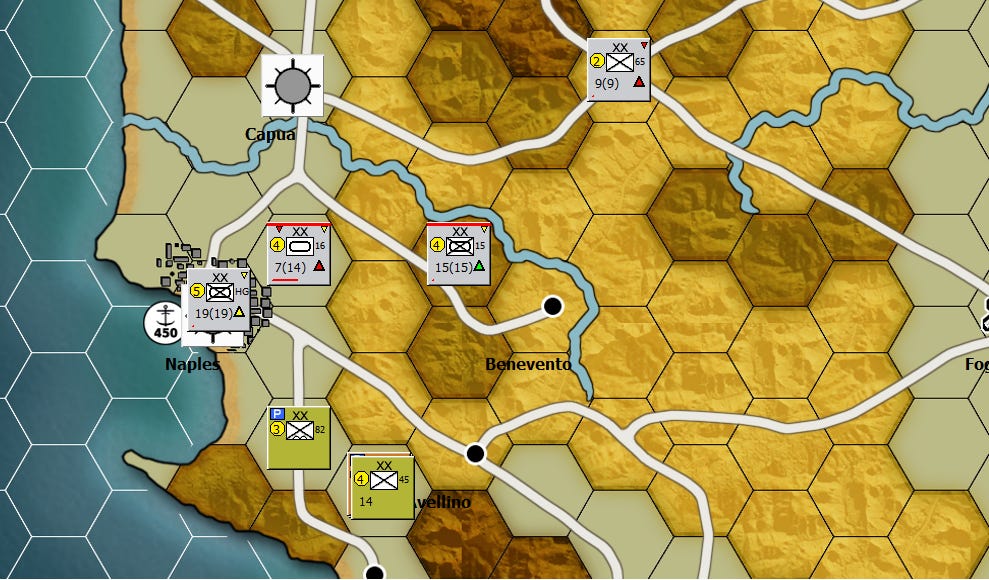
16th Panzer is withdrawn during my orders phase after two failed attacks to stop the Allied advance on the plain west of Avellino.

The Allied AI, however, attacks the 16th before they are fully withdrawn, reducing them significantly. Ultimately I am forced to withdraw them to my fortifications at Capua.
Game note: Tracking unit withdrawals and reinforcements is also very important. The first withdrawal for the Axis is 24th Panzer, fortunately, they weren’t locked in combat when it happened at the beginning of October.
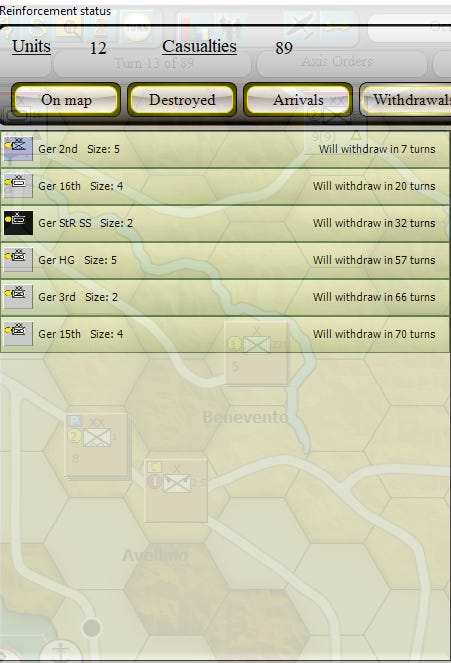
After nearly two months of falling back, I am finally stabilizing a line of defense between Naples and Benevento, but Naples falls to a second Allied attack on October 25, 1943. A major loss to the Axis. I should have added more units to the defense of the port. I had them but didn’t commit them for fear of an amphibious landing close to Rome.

Knowing the campaign history, you can feel the Allied AI gears grinding for an amphibious assault at Anzio or Terracina, behind the Naples line, which is why I defending the coast in-depth and not only at Naples.
The need for reinforcement south of Capua increases and so I prepare the Sturmbrigade Reichsführer SS for combat, by increasing its combat supply from 1 to 2 (3 is best), before they deploy south of that city.

The situation map on October 25, 1943.
Game note: The game counters effectively track unit status, allowing you to eyeball them without further clicking. If you look at the 16th Panzer Division counter in Capua, you can tell the following:
- The yellow circle shows the stacking limit.
- The upper right corner’s upside-down yellow triangle shows that this is a high-quality unit (green = elite, red = average, black = low quality).
- The bottom right corner triangle shows that the unit is out of combat supply, which means it is no longer an offensive formation.
- It has 4 left of its original 14 strength points.
- The colored line at the bottom of the counter is to indicate the amount of disruption on the unit. The longer the red line the greater the level of disruption.

After two Allied attacks fail against the 2nd Parachute division outside of Naples and the 65th infantry division east of Benevento, I funnel more replacements to the 2nd Parachute Division.
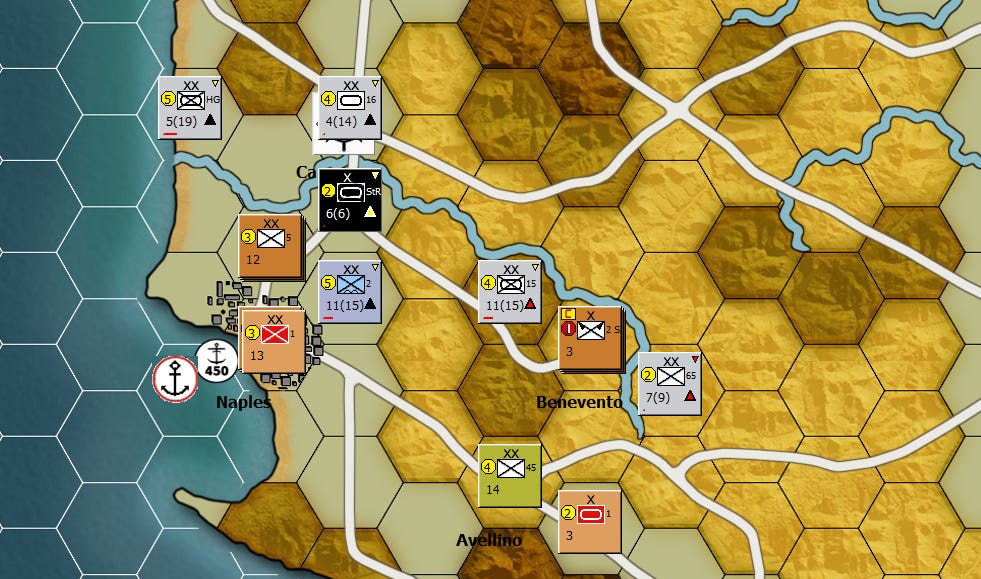
November 2, 1943 situation map.
My defense is wearing thin. After weeks of fighting, the 1st Fallschirm-Panzer Division Hermann Göring, 16th Panzer Division, and 2nd Parachute divisions have all lost combat effectiveness. I funnel replacements into HG, 16th Panzer and move the 65th north. I increase the combat supply for the StR SS brigade, a unit I knew nothing about (use the link for more about their involvement in war crimes).
Look for me to continue this AAR soon, but before I go, some final thoughts:
This is a very interesting game. I am currently playing one of the longer scenarios, but there are also shorter ones (including Sicily). This is a game that I wish Matrix would bring back and expand into North Africa or France. There are scenarios within the game labeled Tunisia 43, France 43 and France 44, but they cannot be accessed from the main menu and seem to be unfinished. My dream would be to play the 1944 France scenario, which is why if I had the money to pay for further development of the game, I would.
The regular purchase price of $39.99 is too steep. My recommendation to Matrix is to permanently lower it to $20, update the map graphics and remarket it as an update that they promote through their social channels and to their email list. At $19.99 they will generate revenue they aren’t getting now because of the higher price point.
In the meantime, if you like this period of warfare, buy it at $10 before the sale ends. Know you are getting a game with a number of worts that is limited to only the Italian theater. That said, I think you will enjoy the game, especially at this price.
Finally, I want to leave you with the designer’s notes in the manual (which I really appreciated):
“One of the first things a wargamer will notice is that the sequence of play is different than the classical design. I prefer simultaneous moves. Also, I prefer that a unit has the ability to perform only one action at a time. So no leave a ZoC, move, enter a different ZoC and attack in this game.
By limiting units to just one major action per turn I had to reduce the time scale so that over a month units would be able to perform a number of actions, including move a given distance, that felt right. With simultaneous moves, the limit of one type of action per turn and a time scale of 4 to 8 moves per month, I had the core of the system I wanted.
The campaign in Italy often seemed close to being a stalemate. Periods where a position became untenable and a grand withdrawal occurred were few although the Allies were always planning for the big breakthrough.
The sequence of play makes breakthroughs difficult to achieve which I think is historical. When using a classic sequence of play a player can move his forces to attack any weak point along a line, make the attacks and then get a mechanized movement phase allowing him to exploit all before the defender can move anyone.
Using the PFE system the attacker and defender will enjoy moments of uncertainty, for example, an attacker moving his forces up to a weak point in the line, then the defender will be able to order his forces to react although since everything is simultaneous the attacks will be going in while the defender is reacting. Nothing being certain neither side will know for sure what the situation will be on the ensuing turn. Will the attacks succeed or fail? Will the defender’s reserves be able to create a new line in time? Does the attacker have fresh forces following up?
The sequence of play, simultaneous with short turns allowing a single type of action, produced the overall feel I wanted where the front is constantly in a state of flux as hexes are gained and lost and limited withdrawals are happening all in an effort to prevent the big breakthrough.
Something else I wanted from the game system was an emphasis on reserves, fresh units, and planning. On the German side, Kesselring always seemed able to scrape together some reserves to deploy to meet a threat or plug a hole. Since the defender is essentially always reacting to the situation one turn in the past, having even just a couple of units in reserve is very important.
Once units are “stuck in” they are difficult to extricate and move to another part of the line. Therefore it is important for the defender to always have a reserve of some sort to plug a hole.
Units wear out as they attack and defend. The way fresh units were handled was in two ways. One, disruption. This value rises as units take hits in combat or lack supply and fall as the unit rests in a well-supplied hex. The other way was using combat supply points. These points give the player some direct control over how ready a unit is to engage with the enemy. Since it requires several turns to bring a unit up to maximum effectiveness and since combat points are not infinite, it requires some level of planning as to which units receive the points and when the unit needs to be ready.
The above covers the base system. I wanted to avoid the need for a lot of chrome and I wanted the system to be as easy to play as possible so I hoped the base system would meet those goals. After that, some chrome was required for the Italian Campaign itself. The system needed amphibious operations and para drops, ground support and interdiction as well as replacements, etc.
When adding chrome I tried to avoid unnecessary complexity and to integrate those areas as smoothly as possible into the base system. I hope the result gives a feel for the Italian Campaign and that the game itself is of interest to players.”


Comments